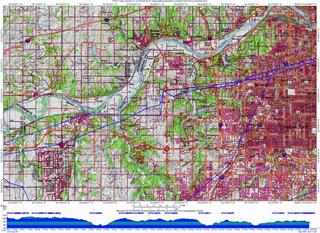Sunday, October 16, 2005
Monticello Ferry Company Kaw Valley Heritage (5o15pm)
 The Tiblow Ferry, first established about 1835 by Tiblow, a Delaware Indian, was located at the site of the present day Bonner Springs.
The Tiblow Ferry, first established about 1835 by Tiblow, a Delaware Indian, was located at the site of the present day Bonner Springs.In 1863 it was chartered by the Monticello Ferry Company, the incorporators being Stephen S. Start, (recorded in some history books as Stuart, which is incorrect), Jacob Trembly, Samuel Garrett, Uriah Garrett of Monitcello. Capital stock of the company was $5,000 divided into shares.
The ferry was operated for many years by Henry Tiblow, son of the above mentioned Tiblow, and has always been referred to as the Tiblow Ferry.
It was located on the early trail between Leavenworth and Paola.
After crossing to the south side of the Kaw River the trail proceeded south easterly toward Monticello, passing through present Greenview Ridge subdivision, and passed a spring and overnight camp site
on the old Garrett farm near 47 th and K7.
From there the trail passed through what is now the Woodsonia subdivision and on through Monticello and Olathe , where it connected with the Santa Fe Trail . At Monticello it connected with the Westport to Lawrence Road taking many travelers and their covered wagons to Oregon.
In 1869 Thomas Dunfree and W.B. White were issued a license to operate a ferry at Tiblow Station. In November 1870 the town of Tiblow was platted and a few years later with arrival of the railroad the name was changed to Bonner Springs.
Note: The "Rimrock Trail" (Red Arrow) is under the stewardship of the Theodore Naish Scout Reservation and sustained by the Heart of America Council Boy Scouts of America (HOAC-BSA) ...

Comments:
<< Home
>> From 1854 to 1857 other ferries were built along the Kaw River. Including the Grinter Ferry, there were at least eleven ferries between the mouth of the river and the western boundaries of Wyandotte County.
These included the Wyandot National Ferry; the Silas Armstrong Ferry; the Willis Wills Ferry, near the river's mouth; the Santa Fe Road Ferry; the Eureka Ferry; the Muncie Ferry, near the present town of Muncie; the Tooley Ferry and Keeler Ferries, approximately two miles west of the Grinter Ferry; the Chouteau Ferry, near Edwardsville; and the Tiblow Ferry, near Bonner Springs.
All of these ferries were vital in the growth of Kansas City, Kansas and the surrounding areas. <<
http://www.kckpl.lib.ks.us/kscoll/lochist/thennow/TN62.htm
These included the Wyandot National Ferry; the Silas Armstrong Ferry; the Willis Wills Ferry, near the river's mouth; the Santa Fe Road Ferry; the Eureka Ferry; the Muncie Ferry, near the present town of Muncie; the Tooley Ferry and Keeler Ferries, approximately two miles west of the Grinter Ferry; the Chouteau Ferry, near Edwardsville; and the Tiblow Ferry, near Bonner Springs.
All of these ferries were vital in the growth of Kansas City, Kansas and the surrounding areas. <<
http://www.kckpl.lib.ks.us/kscoll/lochist/thennow/TN62.htm
CQuest-Keyword Results:
KCK "Local History" Kaw River Ferries
Wyandotte County, Ks History
Illness killed nearly 100 while camped along the Missouri River. ... KS Collection
at the KCK Public Library Kaw Point (Lewis & Clark Park-under ...
@ www.bleedingkansas.org/Wyandotte_County.html
Local History - Kansas City Public Library
GRAND RIVER COLLEGE. GRANDVIEW, MISSOURI. GRASSHOPPER PLAGUE. GRAVES, GINNY.
GRAY, RICHARD ... RAILROADS“INTERURBAN“KANSAS CITY, KAW VALLEY & WESTERN ...
@ www.kclibrary.org/localhistory/collections.cfm?collID=99
Post a Comment
KCK "Local History" Kaw River Ferries
Wyandotte County, Ks History
Illness killed nearly 100 while camped along the Missouri River. ... KS Collection
at the KCK Public Library Kaw Point (Lewis & Clark Park-under ...
@ www.bleedingkansas.org/Wyandotte_County.html
Local History - Kansas City Public Library
GRAND RIVER COLLEGE. GRANDVIEW, MISSOURI. GRASSHOPPER PLAGUE. GRAVES, GINNY.
GRAY, RICHARD ... RAILROADS“INTERURBAN“KANSAS CITY, KAW VALLEY & WESTERN ...
@ www.kclibrary.org/localhistory/collections.cfm?collID=99
<< Home

